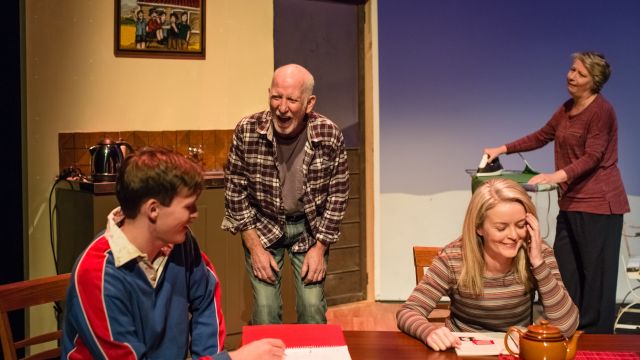Hotel Sorrento
Is Hotel Sorrento really about the ‘ghost’ that has haunted and divided the Moynihan family, or is it a treatise on the Australian attitude to the arts? If it is the latter, does that mean the play is a little dated? That the cultural criticism it makes is less relevant today than it was in 1990 when the play was awarded an AWGIE, a Premier’s Literary Award and a Green Room Award? Or do the cuts in government funding to many of the arts suggest the ‘home grown cringe’ does still exist?
As well as the cultural comment, Hannie Rayson explores the festering effects that secrets and suspicions have on family relationships through the three Moynihan sisters. After the death of her husband, Hilary (Ruth Caro) stays on in the lazy seaside town of Sorrento, supporting her son, nursing her dying mother and humouring her aging father Wal, (Dennis Coard). Pippa (Joanne Booth), on the other hand, has become a successful business woman in New York; and Meg (Kim Denman), a writer living in England, has just been nominated for the Booker Prize for her novel Melancholy, which many believe is autobiographical.
Those aspects of the novel have concerned Hilary and Pippa, and when the sisters gather for their father’s funeral, this tension is further stretched as Hilary’s son Troy (Saxon Gray) begins asking questions about why they are reluctant to talk about the death of his father.
Director Denny Lawrence uses the character of Meg’s English husband, Edwin (Dion Mills), to break the tension. Mills’ quizzical expressions and comic timing provide a break from the conflict around him – as do ‘weekenders’, artist Marge (Jenny Seedsman) and her friend, journalist, Dick (Mike Smith). Rayson employs them as moderators, connecting scenes and ideas – and eventually as a catalyst to a major family implosion.
The wealth of experience of these actors, and Lawrence’s tight direction, means they work as a well-oiled ensemble, essential in a touring production working for short runs in many different theatres. The simple set, designed by Adrienne Chisholm, and lit by Shane Grant, is easilt transported, but still allows the many scene changes – a typical feature of much of Rayson’s work – between house and jetty, Australia and England, beach and beach house, to occur relatively smoothly.
Carol Wimmer
Photographer: Cathy Ronalds
Preview and buy the script here.
Subscribe to our E-Newsletter, buy our latest print edition or find a Performing Arts book at Book Nook.

